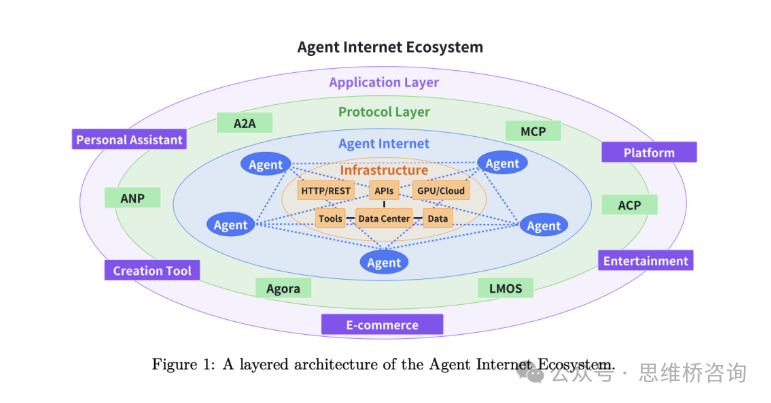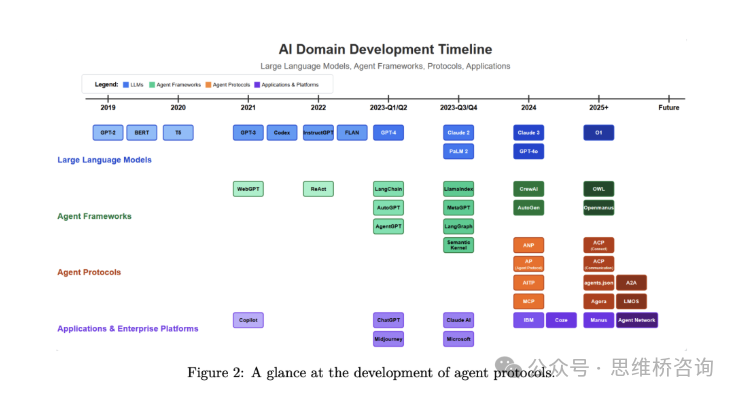 The “Language Barrier” of AI Agents and the Path to Breakthrough
The “Language Barrier” of AI Agents and the Path to Breakthrough
As AI agents driven by large language models (LLMs) accelerate their deployment in enterprises and research, an unexpected yet crucial issue has emerged—communication barriers. In today’s ecosystem of intelligent agents, while they possess autonomous reasoning, planning, and execution capabilities, they struggle to collaborate with other agents or interact with external tools. The lack of standard communication protocols means that interactions between agents often rely on ad-hoc APIs or fragile function call mechanisms, which not only limits system scalability but also leads to fragmented ecosystems and low collaboration efficiency.
This phenomenon is reminiscent of the early days of the internet, when the lack of unified transport and application layer protocols made it difficult for information to flow smoothly between systems. Later, the establishment of TCP/IP and HTTP protocols made a global information network a reality. Today, AI agents find themselves at a similar crossroads. The construction of standardized communication protocols will be a key force in promoting the birth of the “Internet of Agents.”
Recently, a research team from Shanghai Jiao Tong University and the open-source community ANP jointly released a comprehensive survey report that systematically outlines the current state of development of AI agent communication protocols. They proposed a clear theoretical classification system for protocols, evaluated the performance of several mainstream frameworks, and pointed out directions for building a scalable, secure, and highly collaborative agent ecosystem in the future.
 Design Logic and Representative Solutions of Agent Communication Protocols
Design Logic and Representative Solutions of Agent Communication Protocols
The research team proposed a representative “two-dimensional four-quadrant” classification framework to clarify the diversity in the design of agent communication protocols:
-
First Dimension: Context-Oriented Protocols vs. Agent-to-Agent Protocols
-
-
Context-Oriented Protocols emphasize interaction between agents and external resources (such as data sources, tools, APIs);
-
Agent-to-Agent Protocols focus on task assignment, collaboration, and communication among multiple agents.
-
-
Second Dimension: General Protocols vs. Domain-Specific Protocols
-
-
General Protocols pursue broad adaptability across platforms and application scenarios;
-
Domain-Specific Protocols are tailored for specific purposes (such as dialogue systems, robot control, IoT, etc.).
-
Based on this framework, the researchers conducted an in-depth analysis of three representative protocols:
-
MCP (Model Context Protocol) — a context-oriented protocol from AnthropicMCP features a simple design that separates reasoning from execution, enhancing security and system scalability. Its core idea is to process user-sensitive data locally, avoiding direct exposure in function calls generated by LLMs, thereby strengthening privacy protection.
-
A2A (Agent-to-Agent Protocol) — a collaboration protocol proposed by GoogleA2A emphasizes security and asynchronous communication capabilities, making it particularly suitable for complex task processes within enterprises. It supports multimodal data interaction (such as files and streams) through a modular design and uses standardized entities like “agent cards,” “tasks,” and “artifacts” to achieve efficient workflow orchestration.
-
ANP (Agent Network Protocol) — a decentralized protocol developed by the open-source communityANP aims to build an open network based on decentralized identity verification (DID) and semantic meta-protocols, enabling encrypted communication, discovery mechanisms, and task negotiation between different agents. Its layered architecture is highly scalable and represents a strong attempt to build an open “Internet of Agents.”
These protocols each have their design focuses, but they all reflect the trend that future communication systems should balance flexibility, privacy, and cross-domain capabilities.

Comprehensive Evaluation from Efficiency to Interoperability
To systematically evaluate the strengths and weaknesses of AI agent communication protocols, the research team proposed a comprehensive and logically clear set of seven performance evaluation criteria:
-
Efficiency: Focuses on throughput, latency, and computational resource consumption, which is particularly critical in LLM scenarios (such as token cost control).
-
Scalability: Assesses the protocol’s capacity to handle increasing numbers of agents, communication intensification, and dynamic task changes.
-
Security: Covers mechanisms for authentication, access control, and context de-identification to ensure data and behavior are secure and trustworthy.
-
Reliability: Includes robustness of message delivery, traffic control mechanisms, and connection persistence.
-
Extensibility: Whether the protocol allows for functional evolution without breaking compatibility.
-
Operability: Ease of deployment, observability, and platform-independent implementation capabilities.
-
Interoperability: Supports system collaboration across different languages, platforms, and vendors.
This evaluation framework fully incorporates concepts from traditional network protocol design while introducing challenges unique to agents, such as semantic coordination, multi-turn dialogue, and task negotiation processes. This integrated thinking not only helps standardize the development of current protocols but also provides the industry with a unified evaluation standard, avoiding issues of “reinventing the wheel” and “building behind closed doors.”
 The Evolution Blueprint for Next-Generation Agent Protocols
The Evolution Blueprint for Next-Generation Agent Protocols
Behind all communication protocols lies the most visionary goal: to achieve “Collective Intelligence” among agents—where multiple agents can form dynamic teams through standardized interaction mechanisms to solve complex tasks that exceed the capabilities of a single model.
Emerging protocols like Agora further promote this vision, allowing agents to dynamically negotiate and generate new communication protocol documents through LLMs to adapt to changing collaboration needs. Another example is the LOKA protocol, which integrates ethical reasoning and identity management into the communication layer, ensuring that the multi-agent ecosystem possesses auditability, accountability, and ethical transparency during its development.
The research team also proposed a three-phase roadmap for protocol evolution:
-
Short-term goal: Transition from static function calls to dynamically evolvable communication protocols;
-
Mid-term goal: Build an agent ecosystem with self-organization and negotiation capabilities;
-
Long-term vision: Develop a layered protocol infrastructure that supports privacy protection, collaborative intelligence, and modular cooperation.
This means that the future of AI systems is not only about model architecture or training data but also depends on the flexibility and intelligence of the communication systems behind them. Communication protocols are no longer mere technical appendages but the “nervous system” driving the collective evolution of intelligent systems.Click below to read the original article for more details.
